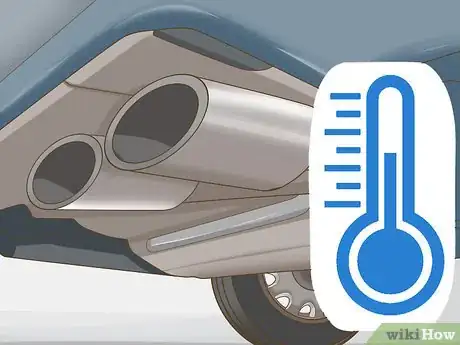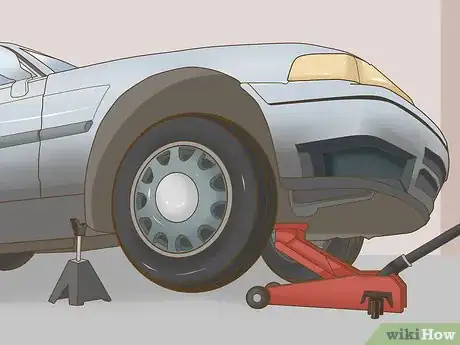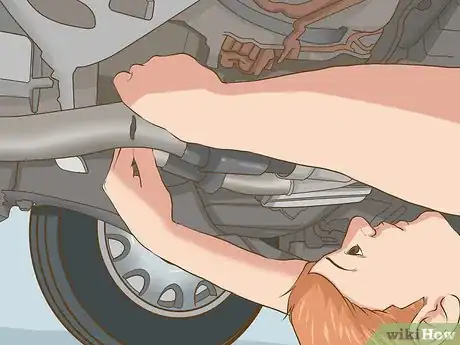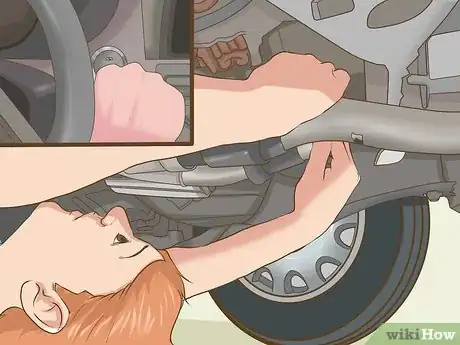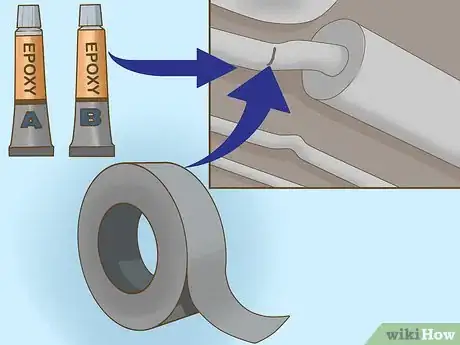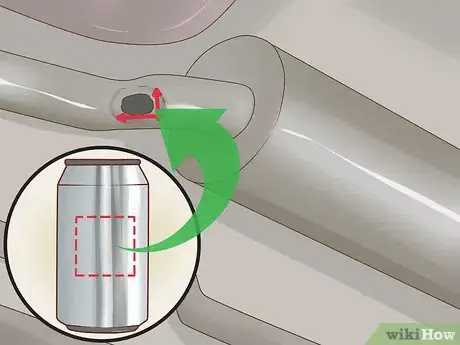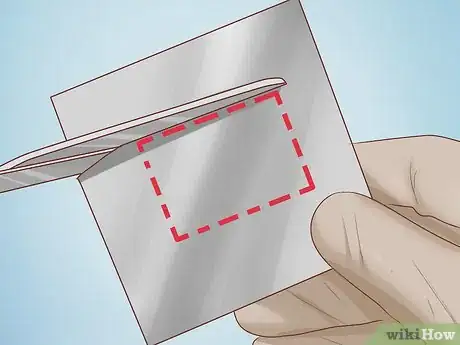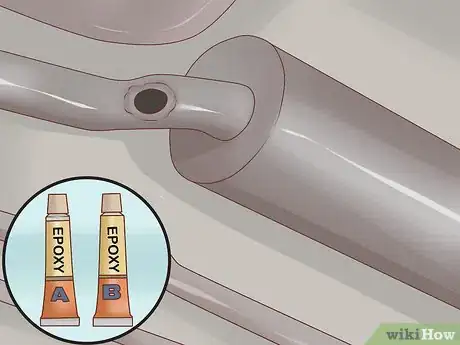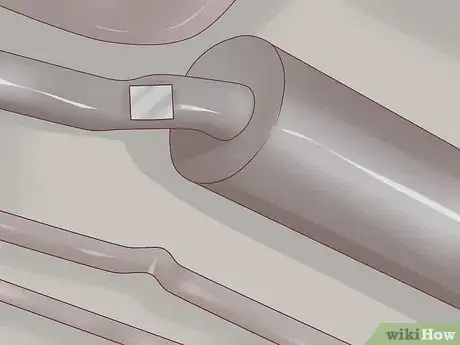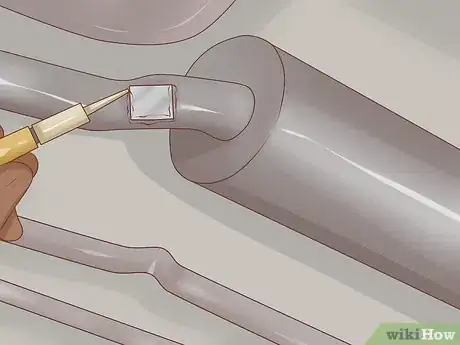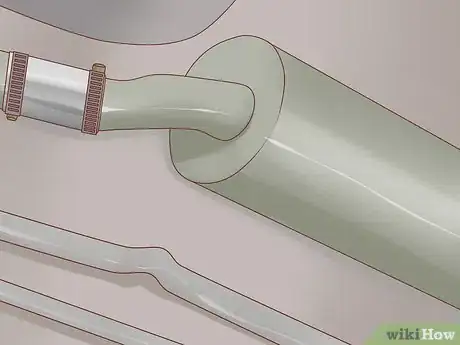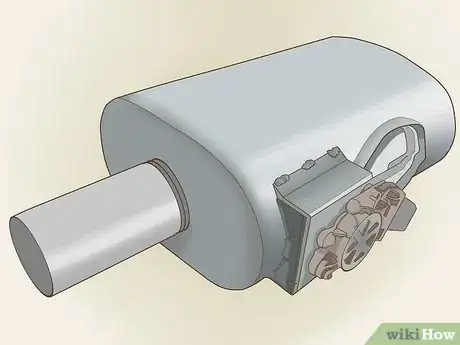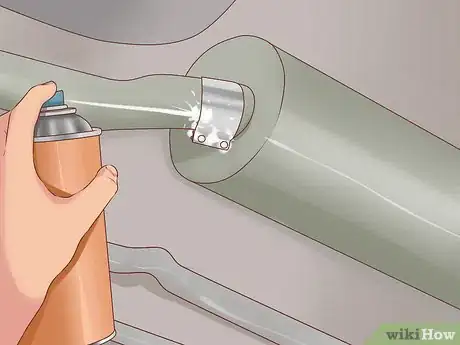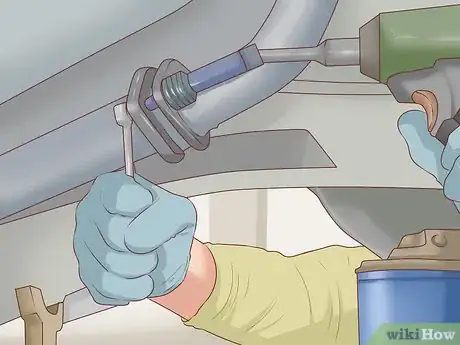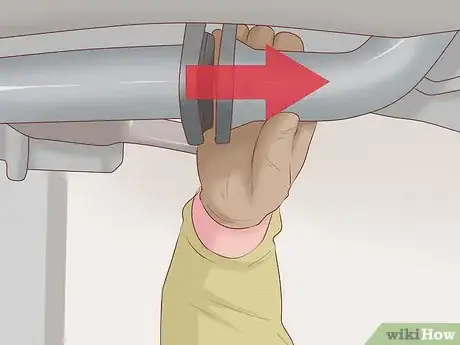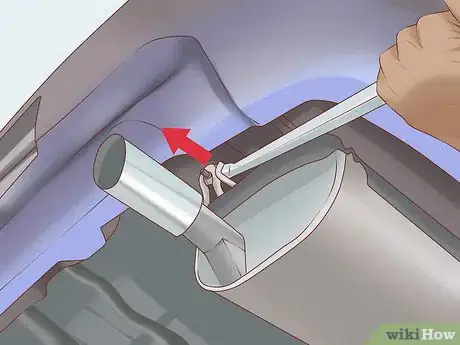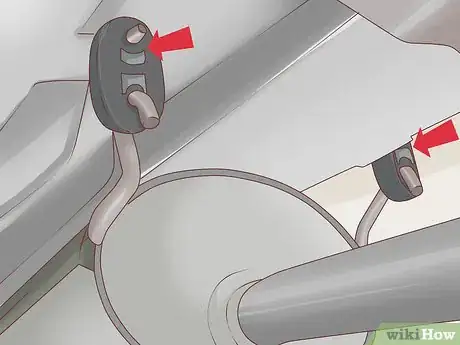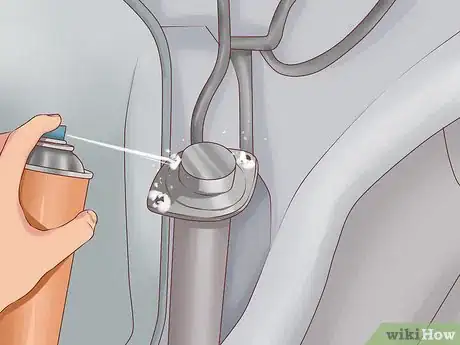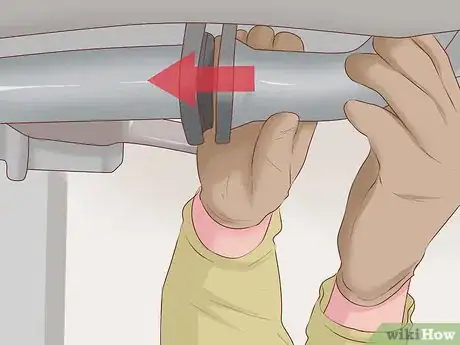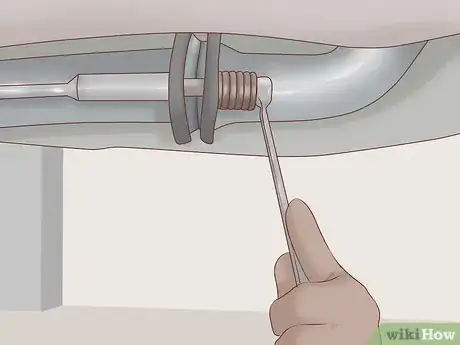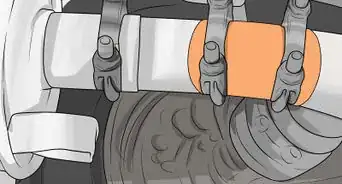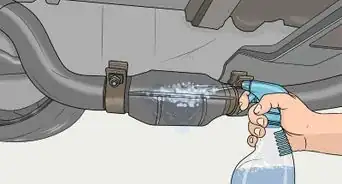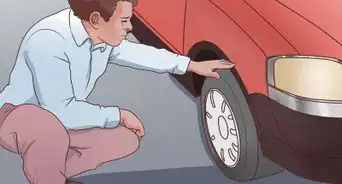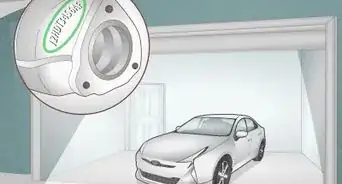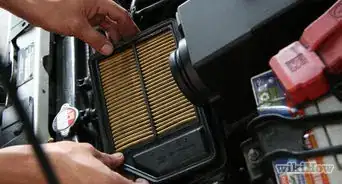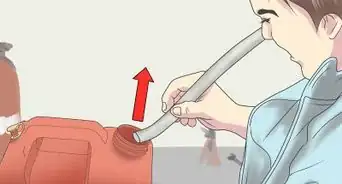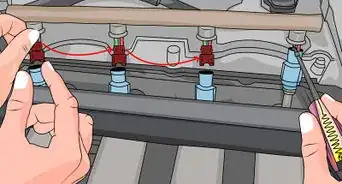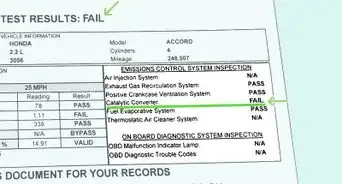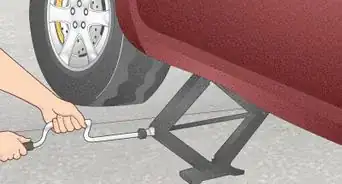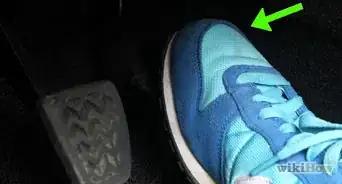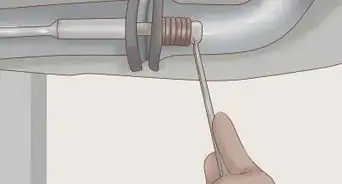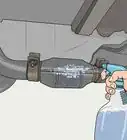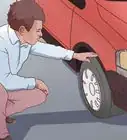This article was co-authored by wikiHow Staff. Our trained team of editors and researchers validate articles for accuracy and comprehensiveness. wikiHow's Content Management Team carefully monitors the work from our editorial staff to ensure that each article is backed by trusted research and meets our high quality standards.
This article has been viewed 61,998 times.
Learn more...
Most stock automotive exhausts are designed to suppress the noise created by the running engine in your vehicle. While there are aftermarket exhausts you can install to change the sound of your vehicle, a stock exhaust should not grow louder over time. If your exhaust is making a lot of noise, it is likely because of a leak. Finding and addressing the leak will often silence your exhaust effectively. However, if your factory exhaust is simply too loud, you can purchase and install a new muffler that is designed for quieter operation.
Steps
Identifying an Exhaust Leak
-
1Park the vehicle on a firm, level surface. When repairing an exhaust leak, the first step is raising the vehicle to a height you can work on. It’s important that you work on a surface that can support that weight of the vehicle beneath the jack. You also need the surface to be level, as it’s extremely unsafe to jack up a car at an angle.[1]
- Black top or concrete are the best surfaces to jack up a car on.
- Never jack up a car on grass, dirt or gravel as it may cause the jack to topple over.
-
2Let the exhaust to cool. While driving, the exhaust piping in your vehicle can reach extremely high temperatures. It may take several hours for the piping to cool enough to he handled as you look around for a leak.[2]
- The longer the engine was running before allowing it to cool, the longer it will take to be able to work on it the exhaust.
- Touch the hood of your car. If it is still warm, the engine and exhaust are both still extremely hot.
Advertisement -
3Jack up the vehicle. Slide a scissor or trolley jack below the vehicle at one of its designated jack points. With the jack in the correct space, jack up the car until it is high enough to safely work beneath it. Using jack stands is extremely important. Never work beneath a vehicle supported only by a jack.[3]
- Once the vehicle is jacked up, place jack stands beneath the vehicle to support its weight.
- If you are unsure where these jack points are, refer to the vehicle’s owner’s manual to help you locate them.
-
4Inspect the exhaust piping for damage. If you believe you know where an exhaust leak may be coming from, examine that area closely for signs of damage. Otherwise, start at the front of the vehicle and work your way back. Look for signs of damage such as scrapes, rust, cracks or holes. Aside from normal damage, be on the lookout for rust. Rust is also a common cause of exhaust leaks. If rust penetrates through all the way through a pipe, it will result in a leak.[4]
- In lower vehicles, exhaust leaks can be caused by the underside of the vehicle bottoming out on things like speed bumps or pot holes.
- Other common causes of exhaust leaks are crushes, punctures and loose hardware.
-
5Start the vehicle to help find leaks. If you can’t find the source of the leak with a visual inspection, ask a friend to start the vehicle. Climb beneath the vehicle with it running to look for signs of smoke leaking out of the pipes..[5]
- Be careful working under a vehicle that is running. Keep your hands away from any moving parts and do not wear loose fitting clothing.
- Make sure the vehicle is in park (automatic transmissions) or is in neutral with the wheels chocked (standard transmissions) before your friend starts it.
-
6Assess the damage and your options. Some damage can easily be repaired at home, while other issues may be beyond your ability or skill set. Once you have identified the leak, consider your repair options. If the exhaust piping is covered in deep rust, that entire section of the exhaust may need to be replaced. Small scrapes or holes can be addressed with patches or an epoxy.[6]
- Small leaks may be repaired using exhaust tape or repair epoxy.
- Larger holes a patch in conjunction with an epoxy to seal the leak.
Sealing a Leak with a Patch
-
1Determine what size patch is needed. Exhaust patch kits can be purchased from most auto parts stores, but in many cases you could also use a simple aluminum can. Scrub and clean the area around the leak, then determine what size patch you will need to be to cover the leak. Leave at least a half inch or so of extra material beyond the hole itself when cutting a can into the right size for a patch.[7]
- You will likely need to have that component of the exhaust replaced if the patch required is longer than about three inches.
- Read the directions on the patch kit you choose to ensure it can repair a leak like the one you’ve identified on your vehicle.
-
2Cut an aluminum patch that fits over the leak. Cut you aluminum can into the size and shape you’ll need to seal the leak, with an additional half inch or so on all sides. You can also wrap the can around the pipe by cutting it down the middle. For smaller leaks, you can simply cut a circle of aluminum that is a half inch larger in diameter than the hole.[8]
- Gloves can protect your hands from being cut by the can while you work.
- Wrapping the can or patch all the way around the pipe will provide the best seal.
-
3Cover the area surrounding the leak with epoxy. Mix the epoxy together and apply it to the leak and the area immediately surrounding it. Make sure to apply enough epoxy to create a seal for the patch, but don’t apply so much that the epoxy begins to drip into the exhaust piping.[9]
- Apply the epoxy to an area surrounding the leak that is equal size to the patch you are applying.
- If you are going to wrap the patch all the way around the pipe, apply most of the epoxy to the area around the leak and a lighter coat all the way around the pipe.
-
4Place the patch over the leak. Either place the small patch directly over the hole or wrap a large patch all the way around the pipe. If wrapping the patch around the pipe, make sure the middle of the patch is over the leak itself. The epoxy should hold the patch in place, but you may need to keep a hand on it until you have it secured.[10]
- It’s okay if some of the epoxy squeezes out the sides of the patch when you apply it.
- Make sure none of the leak extends beyond the sides of the patch.
-
5Apply the epoxy over the patch. Apply the epoxy to the edges of the patch using the tube’s applicator or a wooden dowel. Coating the patch itself with epoxy can strengthen the seal and reduce the chances of the patch leaking. This will also help hold the patch in place as the epoxy dries while creating a more solid seal.[11]
- Coat the perimeter of the patch with epoxy to prevent pinhole seals.
- If you wrapped the entire pipe with a patch, you do not need to coat the entire patch.
-
6Secure a large patch in place with hose clamps. If you chose to wrap the patch all the way around the pipe, use two hose clamps to secure it in place. Place one hose clamp on either side of the leak on the pipe, then tighten the clamps onto the patch and the pipe using the appropriate hand tool.[12]
- The hose clamps will help ensure a good seal on the patch.
- You can use hose clamps over smaller patches as well, though you may only need one.
Replacing the Muffler
-
1Purchase a quieter muffler. There are a number of mufflers available for purchase that are designed for different specific needs. Ask the clerk at your local auto parts store to help you find a muffler that will fit your specific year, make and model vehicle that also offers better sound absorption or dampening.[13]
- You may also be able to find replacement mufflers at large retail outlets.
- Some universal mufflers may fit your needs.
-
2Spray the muffler clamps with a penetrating fluid. Your muffler may have accumulated a good deal of rust due to its constant exposure to water and road grime. Spray a rust penetrator like WD-40 on the bolts and allow it to soak in for a few minutes. If the muffler is secured to the exhaust pipe using a flange, spray the bolts on the flange.
- You may need to use multiple applications of rust penetrator before you can loosen the bolts.
- If the muffler is held in place with muffler clamps, spray the bolts on the clamps.
-
3Use a wrench to loosen the nuts on the muffler clamps. With the rust broken loose thanks to the rust penetrator, find a socket or hand wrench of the appropriate size and loosen the nuts on the exhaust clamp. You will probably need to replace the clamp, so if the bolt breaks, it’s okay.
- You may not be able to reuse highly rusted muffler clamps.
- If you need to replace a muffler clamp, you can purchase replacement ones at your local auto parts store.
-
4Slide the exhaust and muffler apart. Once you have removed the exhaust clamp, respray the area where the muffler pipe meets the exhaust piping with rust penetrator. Allow the penetrator to sit for a few more minutes. You should then be able to pull the muffler toward the back of the car to slip the two pipes apart.
- You may have to cut the pipes apart if they’re rusted together too thoroughly.
- If your muffler was welded in place, you will have to cut the pipes apart.
-
5Pull the muffler off of the rubber mounts. The rubber muffler mounts will hold the muffler in place after it has been removed from the rest of the exhaust piping. The muffler hangs on the mounts with a piece of metal that extends through a rubber eyelet attached to the body of the vehicle. Pull the muffler back and away from the vehicle to pull the metal portion out of the eyelet.
- It will take a good amount of force to release the metal from the eyelet.
- If you tear the rubber eyelet, you can purchase a replacement one at most auto parts stores.
-
6Insert the new muffler hangers in the rubber muffler mounts. Insert the metal prong from the muffler through the rubber eyelet on the vehicle. The rubber will prevent the muffler from rattling or creating a vibrating noise inside the cabin of the vehicle once the muffler is completely installed.
- The rubber eyelet can stretch slightly to allow you to insert the muffler into the piping after you hang it.
- Make sure to replace the rubber eyelet if you damaged it removing the old muffler.
-
7Apply exhaust sealant to the piping. Spray down the piping before you insert the new muffler into the exhaust on your car. Spray on exhaust sealant establishes an air tight seal between the two pipes which will reduce the chances of an exhaust leak where the pipes connect.
- You may need to allow the exhaust sealant to sit for a few minutes before moving on.
- Refer to the instructions on the exhaust sealant to know how long to let it cure.
- You can purchase exhaust sealant at your local auto parts store.
-
8Slide the exhaust together. Slide the muffler piping or adaptor over the existing exhaust pipe. The muffler should rest directly below the rubber eyelet, so the eyelet hangs straight up and down. If the two pipes feel loose or can be wiggled, you will need an adaptor to match the correct size of piping.
- Most exhaust piping comes in two or two-and-a-half-inch diameters.
- You will not be able to seal the wrong size pipe onto another pipe, even by overtightening the muffler clamps.
-
9Secure the exhaust with muffler clamps. Slide a muffler clamp over the area where one pipe overlaps the other with the muffler seated properly. Use a hand or socket wrench to tighten the clamp until it is not possible to move the pipes back and forth at all.
- A half inch drive socket wrench will provide you with the leverage you need to tighten it sufficiently.
- Be sure you tighten the clamp over where the piping overlaps, otherwise you could crush the exhaust piping.
Community Q&A
-
QuestionI went to the nearest auto parts store and asked for a quiet muffler for my car (V8). They gave me one that didn't block as much noise as I would've liked. Are there any quiet mufflers that block V8s?
 Community AnswerFor sound in general, the larger the muffler is, the quieter the sound will be. There are multiple types of mufflers; if you want a quiet one, when you look through the end of it you don't want to see through to the other side; the sound will travel straight through. Mufflers with internal baffles will cause it to be quieter.
Community AnswerFor sound in general, the larger the muffler is, the quieter the sound will be. There are multiple types of mufflers; if you want a quiet one, when you look through the end of it you don't want to see through to the other side; the sound will travel straight through. Mufflers with internal baffles will cause it to be quieter.
References
- ↑ https://axleaddict.com/auto-repair/How-to-Fix-the-Exhaust-Pipe-or-Muffler
- ↑ https://axleaddict.com/auto-repair/How-to-Fix-the-Exhaust-Pipe-or-Muffler
- ↑ http://jalopnik.com/5949291/how-to-fix-your-exhaust-with-an-empty-beer-can
- ↑ https://axleaddict.com/auto-repair/How-to-Fix-the-Exhaust-Pipe-or-Muffler
- ↑ https://axleaddict.com/auto-repair/How-to-Fix-the-Exhaust-Pipe-or-Muffler
- ↑ https://axleaddict.com/auto-repair/How-to-Fix-the-Exhaust-Pipe-or-Muffler
- ↑ http://jalopnik.com/5949291/how-to-fix-your-exhaust-with-an-empty-beer-can
- ↑ http://jalopnik.com/5949291/how-to-fix-your-exhaust-with-an-empty-beer-can
- ↑ https://axleaddict.com/auto-repair/How-to-Fix-the-Exhaust-Pipe-or-Muffler
- ↑ https://axleaddict.com/auto-repair/How-to-Fix-the-Exhaust-Pipe-or-Muffler
- ↑ https://axleaddict.com/auto-repair/How-to-Fix-the-Exhaust-Pipe-or-Muffler
- ↑ https://axleaddict.com/auto-repair/How-to-Fix-the-Exhaust-Pipe-or-Muffler
- ↑ http://www.dragzine.com/tech-stories/exhaust/understanding-muffler-design-and-sound-absorption-strategies/
About This Article
If you need to silence a leaky exhaust, scrub the area around the leak with soapy water so you can see exactly how big the patch needs to be. Cut an aluminum patch so there’s at least an extra 1/2-inch of material all the way around the hole. Cover the area around the leak with epoxy, then place the patch over the leak. If it’s a large patch that wraps around the pipe, you may need to secure it into place with hose clamps. Keep reading to learn how to replace your muffler!

